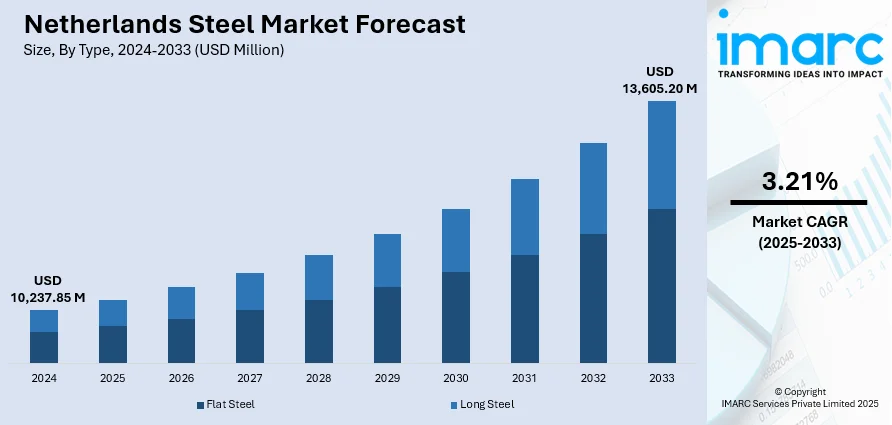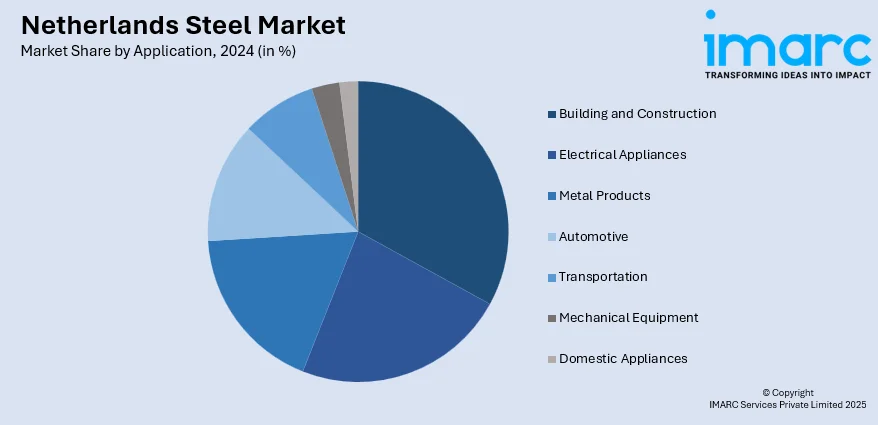
Netherlands Steel Market Size, Share, Trends and Forecast by Type, Product, Application, and Province, 2025-2033
Netherlands Steel Market Overview:
The Netherlands steel market size reached USD 10,237.85 Million in 2024. Looking forward, IMARC Group expects the market to reach USD 13,605.20 Million by 2033, exhibiting a growth rate (CAGR) of 3.21% during 2025-2033. Strong demand from the construction, automotive, and manufacturing sectors is one of the factors contributing to the Netherlands steel market share. Investment in infrastructure, technological advancements in steel production, sustainability trends, and a focus on recycling also contribute to market expansion. Government policies and global trade dynamics play key roles.
|
Report Attribute
|
Key Statistics
|
|---|---|
|
Base Year
|
2024
|
|
Forecast Years
|
2025-2033
|
|
Historical Years
|
2019-2024
|
| Market Size in 2024 | USD 10,237.85 Million |
| Market Forecast in 2033 | USD 13,605.20 Million |
| Market Growth Rate 2025-2033 | 3.21% |
Netherlands Steel Market Trends:
Innovation in Hygienic Steel Equipment
In the Netherlands, there is a noticeable shift toward the development of automated, hygienic steel equipment solutions. Companies are prioritizing safety, efficiency, and cleanliness in their equipment designs. The focus is on eliminating manual handling risks, particularly in industries requiring stringent hygiene standards, such as food and pharmaceuticals. The rise of stainless-steel lifts that automate vertical material movement reflects a growing demand for non-hydraulic, fully hygienic equipment, which offers both enhanced operational safety and space-saving benefits. This innovation is being driven by the need to address gaps in the market where suitable suppliers for such specialized equipment were previously unavailable, aligning with global sustainability and safety standards. These factors are intensifying the Netherlands steel market growth. For example, in January 2025, Dinnissen introduced an innovative stainless-steel lift designed to enhance safety, efficiency, and hygiene. Developed following a project in the US for a dietary supplement company, the lift automates the vertical movement of raw materials, eliminating safety risks associated with manual pallet placement. Fully made of stainless steel to meet strict hygiene standards, the lift was custom-built after the company found no suitable suppliers for a fully hygienic, non-hydraulic solution.

To get more information on this market, Request Sample
Shift to Hydrogen-Based Steel
The Netherlands is witnessing a significant shift toward cleaner steel production, with key industry players focusing on sustainable practices. A major development is the transition of steel production to hydrogen-based methods, which will significantly reduce CO2 emissions. Companies are increasingly aligning with this move, seeking to secure green steel for their operations. Steel, a major contributor to industrial emissions, is now a focal point for companies aiming to reduce their environmental footprint. The adoption of hydrogen-produced steel, as part of this shift, is gaining momentum, supporting industries in their commitment to sustainability while meeting stringent environmental targets. This approach offers a cleaner alternative to traditional steel manufacturing methods, fostering greener supply chains across sectors. For instance, in October 2024, Lindab and Tata Steel Nederland signed a memorandum of understanding to supply Zeremis green steel once the IJmuiden steelworks transitions to hydrogen-based production by 2030. Lindab, a major ventilation systems supplier, aims to reduce its environmental impact, with steel accounting for half of its emissions. This agreement highlights Lindab's commitment to sustainable practices by partnering with Tata Steel to secure environmentally friendly, hydrogen-produced steel for its products.
Netherlands Steel Market Segmentation:
IMARC Group provides an analysis of the key trends in each segment of the market, along with forecasts at the country and provincial levels for 2025-2033. Our report has categorized the market based on type, product, and application.
Type Insights:
- Flat Steel
- Long Steel
The report has provided a detailed breakup and analysis of the market based on the type. This includes flat steel and long steel.
Product Insights:
- Structural Steel
- Prestressing Steel
- Bright Steel
- Welding Wire and Rod
- Iron Steel Wire
- Ropes
- Braids
A detailed breakup and analysis of the market based on the product have also been provided in the report. This includes structural steel, prestressing steel, bright steel, welding wire and rod, iron steel wire, ropes, and braids.
Application Insights:

- Building and Construction
- Electrical Appliances
- Metal Products
- Automotive
- Transportation
- Mechanical Equipment
- Domestic Appliances
A detailed breakup and analysis of the market based on the application have also been provided in the report. This includes building and construction, electrical appliances, metal products, automotive, transportation, mechanical equipment, and domestic appliances.
Provincial Insights:
- Noord-Holland
- Zuid-Holland
- Noord-Brabant
- Gelderland
- Utrecht
- Others
The report has also provided a comprehensive analysis of all the major provincial markets, which include Noord-Holland, Zuid-Holland, Noord-Brabant, Gelderland, Utrecht, and others.
Competitive Landscape:
The market research report has also provided a comprehensive analysis of the competitive landscape. Competitive analysis such as market structure, key player positioning, top winning strategies, competitive dashboard, and company evaluation quadrant has been covered in the report. Also, detailed profiles of all major companies have been provided.
Netherlands Steel Market News:
- In May 2025, Tata Steel Nederland chose Tenova S.p.A. as the lead technology provider for its Green Steel Plan at the IJmuiden complex in the Netherlands. The plan includes replacing its largest blast furnace with an electric arc furnace (EAF) by 2030, aiming for a 40% reduction in CO2 emissions. The project also features the installation of a direct-reduced iron (DRI) plant to boost steel recycling.
Netherlands Steel Market Report Coverage:
| Report Features | Details |
|---|---|
| Base Year of the Analysis | 2024 |
| Historical Period | 2019-2024 |
| Forecast Period | 2025-2033 |
| Units | Million USD |
| Scope of the Report |
Exploration of Historical Trends and Market Outlook, Industry Catalysts and Challenges, Segment-Wise Historical and Future Market Assessment:
|
| Types Covered | Flat Steel, Long Steel |
| Products Covered | Structural Steel, Prestressing Steel, Bright Steel, Welding Wire and Rod, Iron Steel Wire, Ropes, Braids |
| Applications Covered | Building and Construction, Electrical Appliances, Metal Products, Automotive, Transportation, Mechanical Equipment, Domestic Appliances |
| Provinces Covered | Noord-Holland, Zuid-Holland, Noord-Brabant, Gelderland, Utrecht, Others |
| Customization Scope | 10% Free Customization |
| Post-Sale Analyst Support | 10-12 Weeks |
| Delivery Format | PDF and Excel through Email (We can also provide the editable version of the report in PPT/Word format on special request) |
Key Questions Answered in This Report:
- How has the Netherlands steel market performed so far and how will it perform in the coming years?
- What is the breakup of the Netherlands steel market on the basis of type?
- What is the breakup of the Netherlands steel market on the basis of product?
- What is the breakup of the Netherlands steel market on the basis of application?
- What is the breakup of the Netherlands steel market on the basis of province?
- What are the various stages in the value chain of the Netherlands steel market?
- What are the key driving factors and challenges in the Netherlands steel market?
- What is the structure of the Netherlands steel market and who are the key players?
- What is the degree of competition in the Netherlands steel market?
Key Benefits for Stakeholders:
- IMARC’s industry report offers a comprehensive quantitative analysis of various market segments, historical and current market trends, market forecasts, and dynamics of the Netherlands steel market from 2019-2033.
- The research report provides the latest information on the market drivers, challenges, and opportunities in the Netherlands steel market.
- Porter's five forces analysis assist stakeholders in assessing the impact of new entrants, competitive rivalry, supplier power, buyer power, and the threat of substitution. It helps stakeholders to analyze the level of competition within the Netherlands steel industry and its attractiveness.
- Competitive landscape allows stakeholders to understand their competitive environment and provides an insight into the current positions of key players in the market.
Need more help?
- Speak to our experienced analysts for insights on the current market scenarios.
- Include additional segments and countries to customize the report as per your requirement.
- Gain an unparalleled competitive advantage in your domain by understanding how to utilize the report and positively impacting your operations and revenue.
- For further assistance, please connect with our analysts.
 Request Customization
Request Customization
 Speak to an Analyst
Speak to an Analyst
 Request Brochure
Request Brochure
 Inquire Before Buying
Inquire Before Buying




.webp)




.webp)












